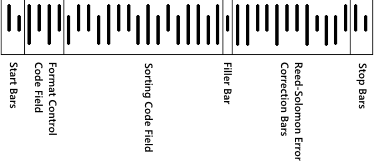Australia Post 4-State Customer Code

Australia Post 4-State Customer Code is used by Australia Post for faster automatic processing of bulk mail. It is a variation of the Royal Mail 4-State Customer Barcode.
Australia Post 4-State Customer Code is defined in the Australia Post A Guide to Printing the 4-State Barcode document.
The symbol comprises the following elements:
-
Start bars: The first two bars are the start bars. Together with the stop bars, they determine the orientation of the barcode symbol. They always have the values 1 and 3, respectively.
-
Format Control Code (FCC) field: This field identifies the format of the barcode. There are six formats: Standard Customer Barcode, Customer Barcode 2, Customer Barcode 3, Reply Paid Barcode, Redirection Barcode, and Currently Reserved. The FCC field uses bars 3 through 6.
-
Sorting code field: This field encodes the eight-digit Delivery Point Identifier (DPID) that identifies the destination address. This field uses bars 7 through 22.
-
Customer information field: This field is used only in the Customer Barcode 2 and Customer Barcode 3 formats. The field is 16 or 31 bars long, depending on the format.
-
Filler bar: Filler bars are used as padding when the information in the customer information field contains fewer than 16 or 31 bars. The filler bars are tracker bars that have a value of 3.
-
Reed-Solomon error correction bars: This field is used to validate the barcode. It is 12 bars long and is always located just before the stop bars.
-
Stop bars: The last two bars. Together with the start bars, they determine the orientation of the barcode symbol. They always have the values 1 and 3, respectively.
In addition, Australian Post 4-State Customer Code requires a quiet zone space of at least 6 mm on either side and 2 mm above and below.
The term "4-state" is derived from the fact that each bar in this symbology is in one of four states, each of which has its own numerical value. The names of the four states and their corresponding values are as follows:
-
T (tracker), value = 3
-
D (tracker, descender), value = 2
-
A (tracker, ascender), value = 1
-
H (tracker, ascender, descender), value = 0
The following diagram illustrates each field in the Standard Customer Barcode format.

This symbology supports the following alphanumeric characters:
Australian Post 4-State Customer Code uses the Reed-Solomon algorithm for error correction.
The density for Australia Post 4-State Customer Code is 22 to 25 bars per 25.4 millimeters. Each format has the following minimum and maximum lengths.
|
Barcode format and FCC
|
Total bars per format
|
Minimum length
|
Maximum length
|
|
Standard Customer Barcode (37)
|
37
|
37.0 mm
|
42.2 mm
|
|
Customer Barcode 2 (52)
|
52
|
52.2 mm
|
59.5 mm
|
|
Customer Barcode 3 (67)
|
67
|
67.5 mm
|
76.8 mm
|
|
Reply Paid Barcode (45)
|
37
|
-----
|
-----
|
Australia Post 4-State Customer Code must be printed parallel to the bottom (long) edge of the piece of mail. The barcode must also be within the following margins:
-
No less than 15 mm from the bottom edge
-
No more than 100 mm up from the bottom edge
-
No less than 20 mm down from the top edge
-
No less than 15 mm from either side
Other things to consider when positioning the barcode include the following:
-
No part of the barcode may appear in the cancelling and metering zone. The metering zone is 40 mm from the top edge and 90 mm from the right edge.
-
Regardless of where the barcode is positioned, the address must appear in the address zone. The address zone is in the same area where the barcode may be placed, except the top margin is 40 mm instead of 20 mm.
-
The preferred position of the barcode is right above the address.


